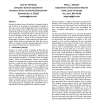Free Online Productivity Tools
i2Speak
i2Symbol
i2OCR
iTex2Img
iWeb2Print
iWeb2Shot
i2Type
iPdf2Split
iPdf2Merge
i2Bopomofo
i2Arabic
i2Style
i2Image
i2PDF
iLatex2Rtf
Sci2ools
SIGCSE
2002
ACM
2002
ACM
Participatory design in a human-computer interaction course: teaching ethnography methods to computer scientists
Empirical evidence shows the ability for computer technology to deliver on its promises of enhancing our quality of life relies on how well the application fits our understanding of how things work. Software designers need to apply methods that provide insights into the user's mental model of the application's target task and to invite the user to be an active participant in the design process. This paper reports on our efforts to design an HCI curriculum around ethnographic techniques of data gathering and paper prototyping. Initial results are presented that study the course's effects on student's attitudes regarding approaches to software design and their long term design behavior. 1 Participatory Design Design is a creative activity of making artifacts that are usable for some specific task. Software design in particular strives for creating products that enrich the interaction between humans and computer applications. While the software programmer/engineer is ...
Design | Education | SIGCSE 2002 | Software | Software Designer |
| Added | 23 Dec 2010 |
| Updated | 23 Dec 2010 |
| Type | Journal |
| Year | 2002 |
| Where | SIGCSE |
| Authors | Jerry B. Weinberg, Mary L. Stephen |
Comments (0)

